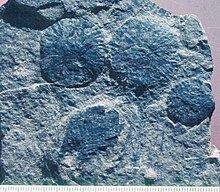Cylostrobus
Appearance
| Cylostrobus Temporal range:
| |
|---|---|

| |
| Cones of Cylostrobus sydneyensis from the Early Triassic Newport Formation near Narrabeen, NSW, Australia.[1] | |
| Scientific classification | |
| Kingdom: | Plantae |
| Clade: | Tracheophytes |
| Clade: | Lycophytes |
| Class: | Lycopodiopsida |
| Order: | Isoetales |
| Family: | †Pleuromeiaceae |
| Genus: | †Cylostrobus Retallack 1995 |
| Species | |
| |



Cylostrobus is genus of Lycopsida most like Pleuromeia, but with very compact and round cones. It is known from the Early Triassic of Australia, coincident with a marked greenhouse spike at the end of the Early Triassic.[2] The genus Cylostrobus was erected for the compact cone only, in the paleobotanical system of form genera, but these small plants are well enough understood that the name Cylostrobus sydneyensis is used for the whole plant, rather than the old name Pleuromeia longicaulis. Other species of Pleuromeia have attached cones that are less compact and produce different spores.
See also
[edit]References
[edit]- ^ Retallack, Gregory J. (1997). "Earliest Triassic origin of Isoetes and quillwort evolutionary radiation". Journal of Paleontology. 7 (3): 500–521. doi:10.1017/S0022336000039524.
- ^ Retallack, Gregory J. (2013). "Permian and Triassic greenhouse crises". Gondwana Research. 24 (1): 90–103. Bibcode:2013GondR..24...90R. doi:10.1016/j.gr.2012.03.003.
